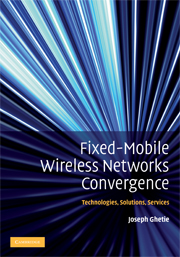Book contents
- Frontmatter
- Contents
- Disclaimer
- How the Book is Organized
- List of Figures
- List of Tables
- Preface
- Acknowledgments
- Acronyms
- Part I Wireless Communications: Networking and Management
- Part II Cellular Mobile Radio Networking and Management
- Part III Fixed Wireless Technologies: Networking and Management
- Part IV Fixed Wireless Cellular Mobile Networks Convergence and Integration
- Part V Fixed Wireless Cellular Mobile Networks Convergence: Standardized Networking Solutions
- 15 UMA-based Fixed Wireless and Cellular Mobile Networking Solutions and Products
- 16 Session Initiation Protocol
- 17 IMS-based Fixed Wireless and Cellular Mobile Networking Solutions and Products
- Part VI Fixed-Mobile Convergence Services, Industry Trends, and Implementation Issues
- References
- Index
16 - Session Initiation Protocol
from Part V - Fixed Wireless Cellular Mobile Networks Convergence: Standardized Networking Solutions
Published online by Cambridge University Press: 21 August 2009
- Frontmatter
- Contents
- Disclaimer
- How the Book is Organized
- List of Figures
- List of Tables
- Preface
- Acknowledgments
- Acronyms
- Part I Wireless Communications: Networking and Management
- Part II Cellular Mobile Radio Networking and Management
- Part III Fixed Wireless Technologies: Networking and Management
- Part IV Fixed Wireless Cellular Mobile Networks Convergence and Integration
- Part V Fixed Wireless Cellular Mobile Networks Convergence: Standardized Networking Solutions
- 15 UMA-based Fixed Wireless and Cellular Mobile Networking Solutions and Products
- 16 Session Initiation Protocol
- 17 IMS-based Fixed Wireless and Cellular Mobile Networking Solutions and Products
- Part VI Fixed-Mobile Convergence Services, Industry Trends, and Implementation Issues
- References
- Index
Summary
What is the Session Initiation Protocol-SIP?
The Session Initiation Protocol (SIP) is an Internet application layer protocol designed to control voice calls or multimedia session setups. SIP is a family of IETF-recommendations and draft standards that provide signaling specifications for Internet conferencing, VoIP, event notifications, and instant messaging over IP-based networks.
SIP-based signaling serves as multimedia call control between calling parties, and is used to set up calling sessions such as audio/video conferences, peer-to-peer communications, or to just indicate the caller's presence. SIP works in tandem with another application layer protocol, Session Description Protocol (SDP), hence the tandem abbreviation of SIP/SDP.
As indicated in Figure 16.1, there are three major components that make up a SIP network/system: Endpoints SIP User Agents (SIP-UA), the callers and beneficiaries of services; SIP Proxies (SIP-P), acting as relays of SIP messages; and SIP Registrars (SIP-R), acting as SIP directories.
As indicated with broken lines, communications between SIP UA and SIP Proxies as well as between SIP Proxies is limited to signaling. The actual transport service is delivered by specialized Applications Servers (AS) such as VoIP Servers, Presence Servers or Push-to-Talk over Cellular (PoC) Servers. The user information, data or digitized voice/video multimedia, is carried in separate frames and packets, using different transport protocols.
SIP System Architecture
A high-level SIP-based functional model is indicated in Figure 16.2.
Communications between SIP User Agents may use a series of SIP proxies that relay SIP/SDP call setup messages.
- Type
- Chapter
- Information
- Fixed-Mobile Wireless Networks ConvergenceTechnologies, Solutions, Services, pp. 303 - 323Publisher: Cambridge University PressPrint publication year: 2008



